
Concept explainers
(a)
Interpretation:
The synthesis of given compound from the given starting material is to be stated.
Concept Introduction:
Organolithium compounds can be formed by the reaction of
Answer:
The synthesis of given compound from given starting material is shown below.
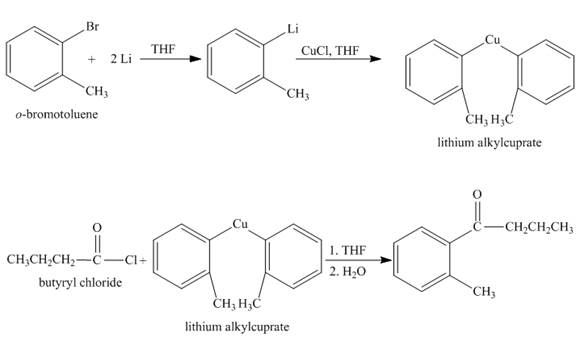
Explanation:
The given compound
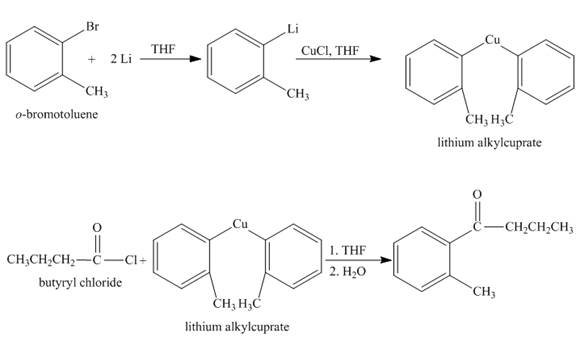
Figure 1
Conclusion:
The synthesis of given compound is shown in Figure 1.
Answer to Problem 21.56AP
The synthesis of given compound from given starting material is shown below.

Explanation of Solution
The given compound

Figure 1
The synthesis of given compound is shown in Figure 1.
(b)
Interpretation:
The synthesis of given compound from the given starting material is to be stated.
Concept Introduction:
Grignard reagent is formed when alkyl halide compound reacts with magnesium in presence of ether. Potassium dichromate is a strong oxidizing agent. It can easily oxidize alcohol group to
Answer to Problem 21.56AP
The synthesis of given compound from given starting material is shown below.
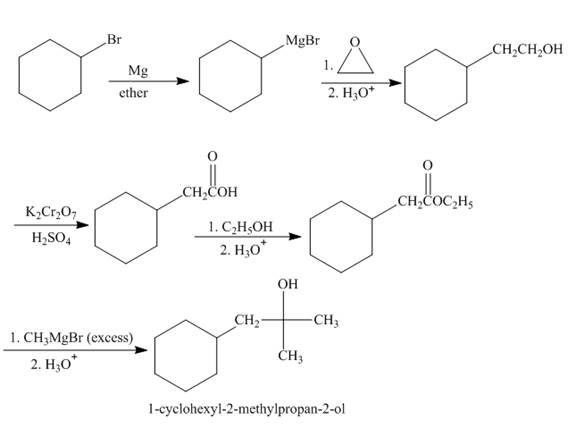
Explanation of Solution
Bromocyclohexane when reacted with magnesium in the ether, it will form grignard reagent. Then grignard reagent will react with
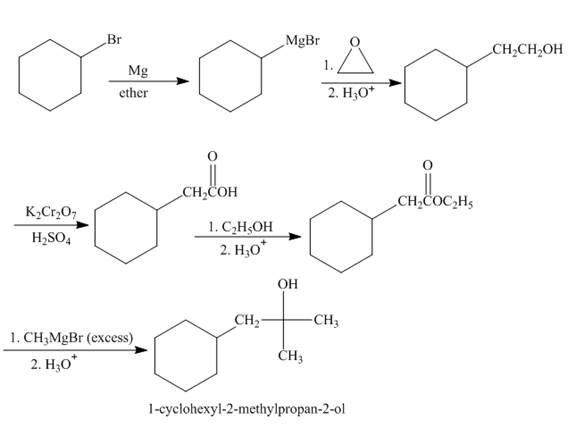
Figure 2
The synthesis of given compound is shown in Figure 2.
(c)
Interpretation:
The synthesis of given compound from the given starting material is to be stated.
Concept Introduction:
The carboxylic acid compound reacts with ammonia to form the amide compound. The carbonyl carbon of acid is electrophilic in nature and the lone pair of nitrogen atom of ammonia acts as nucleophile. They will undergo the nucleophilic substitution reaction. Lithium aluminium hydride is a strong reducing agent.
Answer to Problem 21.56AP
The synthesis of given compound from given starting material is shown below.
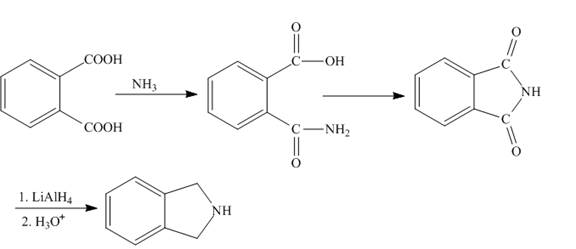
Explanation of Solution
The phthalic acid reacts with ammonia, the lone pair of ammonia nitrogen attacks the carbonyl carbon atom and then with the removal of water molecule phthalamic acid is formed. Then phthalamic acid undergoes cyclization reaction to form phthalamide. Phthalamide upon reduction with lithium aluminium hydride e form the desired product. The synthesis of the given compound is shown below.
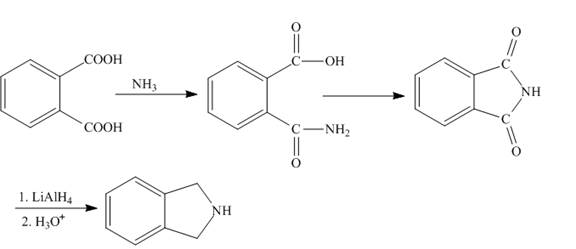
Figure 3
The synthesis of given compound is shown in Figure 3.
(d)
Interpretation:
The synthesis of given compound from the given starting material is to be stated.
Concept Introduction:
Acid can be converted into acid chloride by the reaction of acid with
Answer to Problem 21.56AP
The synthesis of given compound from given starting material is shown below.

Explanation of Solution
The isovaleric acid reacts with

Figure 4
The synthesis of given compound is shown in Figure 4.
(e)
Interpretation:
The synthesis of given compound from the given starting material is to be stated.
Concept Introduction:
Sodium borohyride is a reducing agent. It reduces the
Answer to Problem 21.56AP
The synthesis of given compound from given starting material is shown below.
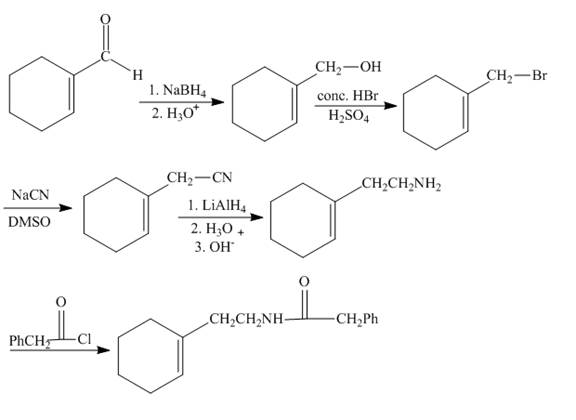
Explanation of Solution
The given starting material reacts with sodium borohydride to convert the carbonyl group into the alcohol group. The reaction of alcohol with hydrogen bromide forms bromoalkene compound. Bromoalkene reacts with the sodium cyanide to form nitrile compound. The nitrile upon reduction forms amine. The amine functional group when reacts with the acid chloride it forms the amide. The synthesis is shown below.

Figure 5
The synthesis of given compound is shown in Figure 5.
(f)
Interpretation:
The synthesis of given compound from the given starting material is to be stated.
Concept Introduction:
Cyanohydrin can be formed on reaction of ketone with cyanide. It is a nucleophilic addition reaction. The cyanide ion acts as nucleophile and carbonyl carbon is electrophile. Nitrile group can be converted into amine by reduction with lithium aluminium hydride.
Answer to Problem 21.56AP
The synthesis of given compound from given starting material is shown below.
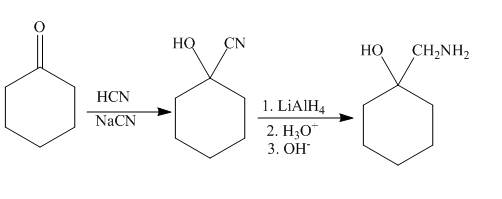
Explanation of Solution
Ketones react with the hydrogen cyanide to form cyanohydrin. The cyanide ion acts as the nucleophile and attacks the electrophilic carbon of the carbonyl group. The cyano hydrin formed will undergo reduction in presence of lithium aluminium hydride to reduce the cyanide group to amine group. The synthesis of the given compound is shown below.

Figure 6
The synthesis of given compound is shown in Figure 6.
(g)
Interpretation:
The synthesis of given compound from the given starting material is to be stated.
Concept Introduction:
Nitration reaction is the reaction in which nitro derivatives are formed. The mixture of nitric acid and sulfuric acid is used as the nitrating mixture. Benzoic acid upon nitration form meta nitrobenzoic acid. The reaction of carboxylic acid with sodium hydroxide produces sodium salt of carboxylic acid.
Answer to Problem 21.56AP
The synthesis of given compound is shown below.
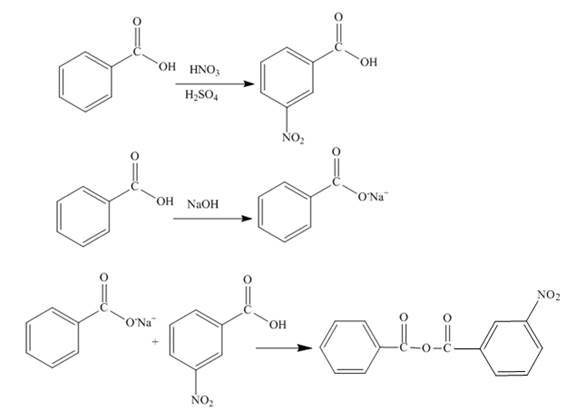
Explanation of Solution
The benzoic acid undergoes nitration reaction in presence of nitric acid and sulfuric acid. The meta product is formed upon nitration of benzoic acid. The meta-nitrobenzoic acid is formed on nitration of benzoic acid. Sodium salt of benzoic acid is formed when benzoic acid reacts with sodium hydroxide. The reaction between the meta-nitrobenzoic acid and sodium salt of benzoic acid forms the desired product. The synthesis of the given compound is shown below.

Figure 7
The synthesis of given compound is shown in Figure 7.
(h)
Interpretation:
The synthesis of given compound from the given starting material is to be stated.
Concept Introduction:
Acid can be converted into acid chloride by the reaction of acid with
Answer to Problem 21.56AP
The synthesis of given compound is shown below.
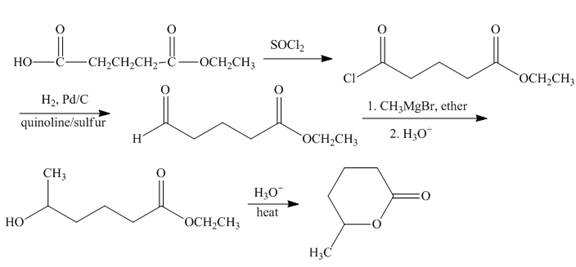
Explanation of Solution
The carboxylic acid group is converted into the acid chloride group by reaction of acid with thionyl chloride. Acid chloride undergoes catalytic reduction to form aldehyde group. Methyl magnesiumbromide converted the product into alkylated secondary alcohol. The formed hydroxy ester compound undergoes cyclization reaction to form the lactone. The synthesis of the given compound is shown below.

Figure 8
The synthesis of given compound is shown in Figure 8.
(i)
Interpretation:
The synthesis of given compound from the given starting material is to be stated.
Concept Introduction:
Potassium permanganate is a strong oxidizing agent. It will oxidize the alkyl group directly to the carboxylic acid group. Thionyl chloride is used for chlorinating the carboxylic acid group. Acid chloride and amines reacts to form the amide linkage.
Answer to Problem 21.56AP
The synthesis of given compound is shown below.

Explanation of Solution
The compound,

Figure 9
The synthesis of given compound is shown in Figure 9.
(j)
Interpretation:
The synthesis of given compound from the given starting material is to be stated.
Concept Introduction:
Chloro formic esters and carbonates are formed when phosgene reacts with alcohol compounds. The carbon of phosgene is electrophilic in nature. The phosgene reacts with alcohol and amines. Lone pair of oxygen atom in the alcohol compounds acts as the nucleophilie. Thus nucleophilic substitution reaction can occur.
Answer to Problem 21.56AP
The synthesis of given compound is shown below.
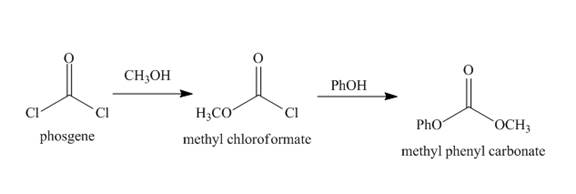
Explanation of Solution
Phosgene has an electrophilic carbon centre. The lone pair of oxygen atom of alcohol acts as nucleophile and attacks at the electrophilic carbon of phosgene. Chloride ion acts as the leaving group. The phosgene reacts with methanol to form methyl chloroformate. Then methyl chloroformate reacts with phenol to form the methyl phenyl carbonate. The complete synthesis is shown below.

Figure 10
The synthesis of given organic compound is shown in Figure 10.
(k)
Interpretation:
The synthesis of given compound from the given starting material is to be stated.
Concept Introduction:
The formation of biaryls by the coupling of aryl halides is known as Ullmann reaction. The reaction takes place in the presence of copper. The reaction proceeds via radical mechanism. The thoinyl chloride reacts with acid to form acid chloride. Potassium permangenate is a strong oxidizing agent which convert alkyl group directly into acid group.
Answer to Problem 21.56AP
The synthesis of given organic compound is shown below.
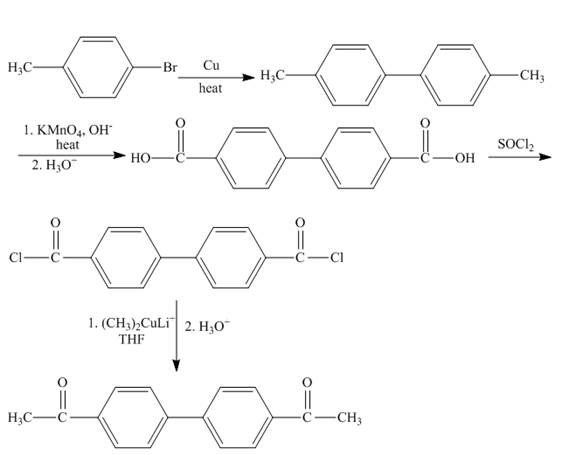
Explanation of Solution
The

Figure 11
The synthesis of given compound is shown in Figure 11.
Want to see more full solutions like this?
Chapter 21 Solutions
EBK ORGANIC CHEMISTRY STUDY GUIDE AND S
- 1. Identify the following alkenes as E or Z NH₂ Br 2. Draw the structures based on the IUPAC names (3R,4R)-3-bromo-4-fluoro- 1-hexene (Z)-4-bromo-2-iodo-3-ethyl- 3-heptene تر 3. For the following, predict all possible elimination product(s) and circle the major product. HO H₂SO4 Heat 80 F4 OH H2SO4 Heat 어요 F5 F6 1 A DII 4 F7 F8 F9 % & 5 6 7 * ∞ 8 BAB 3 E R T Y U 9 F D G H J K O A F11 F10arrow_forwardDraw the major product of this reaction. Ignore inorganic byproducts. ○ O 1. H₂O, pyridine 2. neutralizing work-up a N W X 人 Parrow_forward✓ Check the box under each molecule that has a total of five ẞ hydrogens. If none of the molecules fit this description, check the box underneath the table. tab OH CI 0 Br xx Br None of these molecules have a total of five ẞ hydrogens. esc Explanation Check caps lock shift 1 fn control 02 F2 W Q A N #3 S 80 F3 E $ t 01 205 % 5 F5 & 7 © 2025 McGraw Hill LLC. All Rights Reserved. Terms of Use | Privacy Center | Accessibility FT * 8 R T Y U כ F6 9 FIG F11 F D G H J K L C X V B < N M H option command P H + F12 commandarrow_forward
- Draw the major product of this reaction. Ignore inorganic byproducts and the carboxylic acid side product. O 1. CHзMgBr (excess) 2. H₂O ✓ W X 人arrow_forwardIf cyclopentyl acetaldehyde reacts with NaOH, state the product (formula).arrow_forwardDraw the major product of this reaction. Ignore inorganic byproducts. N S S HgCl2, H2SO4 く 8 W X Parrow_forward
- tab esc く Drawing the After running various experiments, you determine that the mechanism for the following reaction occurs in a step-wise fashion. Br + OH + Using this information, draw the correct mechanism in the space below. 1 Explanation Check F2 F1 @2 Q W A os lock control option T S # 3 80 F3 Br $ 4 0105 % OH2 + Br Add/Remove step X C F5 F6 6 R E T Y 29 & 7 F D G H Click and drag to start drawing a structure. © 2025 McGraw Hill LLC. All Rights Reserved. Terms of Use | Privacy Ce A F7 DII F8 C Ո 8 * 9 4 F10 F C J K L C V Z X B N M H command P ge Coarrow_forwardIndicate compound A that must react with ethylbenzene to obtain 4-ethylbenzene-1-sulfonic acid. 3-bromo-4-ethylbenzene-1-sulfonic acid.arrow_forwardPart 1 of 2 Draw the structure of A, the minor E1 product of the reaction. esc I Skip Part Check H₂O, D 2 A + Click and drag to start drawing a structure. -0- F1 F2 1 2 # 3 Q A 80 F3 W E S D F4 $ 4 % 5 F5 ㅇ F6 R T Y F G X 5 & 7 + Save 2025 McGraw Hill LLC. All Rights Reserved. DII F7 F8 H * C 80 J Z X C V B N 4 F9 6arrow_forward
- File Preview The following is a total synthesis of the pheromone of the western pine beetle. Such syntheses are interesting both because of the organic chemistry, and because of the possibility of using species specific insecticides, rather than broad band insecticides. Provide the reagents for each step. There is some chemistry from our most recent chapter in this synthesis, but other steps are review from earlier chapters. (8 points) COOEt COOEt A C COOEt COOEt COOH B OH OTS CN D E See the last homework set F for assistance on this one. H+, H₂O G OH OH The last step is just nucleophilic addition reactions, taking the ketone to an acetal, intramolecularly. But it is hard to visualize the three dimensional shape as it occurs. Frontalin, pheromone of the western pine beetlearrow_forwardFor the reaction below: 1. Draw all reasonable elimination products to the right of the arrow. 2. In the box below the reaction, redraw any product you expect to be a major product. C Major Product: Check + ◎ + X ง © Cl I F2 80 F3 I σ F4 I F5 NaOH Click and drawing F6 A 2025 McGraw Hill LLC. All Rights E F7 F8 $ # % & 2 3 4 5 6 7 8 Q W E R T Y U A S D F G H Jarrow_forwardCan I please get help with this graph. If you can show exactly where it needs to pass through.arrow_forward
